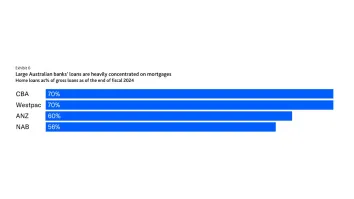
What are today's most disruptive banking technologies?
These banking innovations give us a glimpse at the future of finance.
Banking has gone from being a mechanical means for monetary transactions to an immersive financial experience that goes beyond traditional brick and mortar stores, thanks to technological advances that continue to bring customers more secure, smarter, faster, and infinitely more convenient transaction options. With their easy access to capital, banks can continually push for bleeding edge technologies that provide value for existing clients and give prospects the incentive they need to hop aboard.
Alex Campbell, Xero managing director for Asia, noted this critical change in how banks function, saying that “banks have historically operated as closed systems, but there has been a significant increase in the number of banks and financial institutions opening up to collaborate with technology companies to drive innovative solutions for their shared customers.”
Indeed, collaboration between banks and innovators has dramatically changed how businesses interact and transact with the former. With rapid digitalisation across multiple industries, “banks in particular must continue to work with technology companies to stay ahead of the digital curve and meet these demands and remain competitive,” Campbell noted.
And competitiveness is what David Haynes, head of KYC, AML, and financial crimes solutions APAC at LexisNexis Risk Solutions, sees in today’s banking landscape. Consumers demand the best solutions from their bank of choice, and banks can’t afford to even catch their breath. Haynes said that “banks are working hard to create an optimal customer experience for consumers and small businesses; an experience that is low-friction whilst at the same time one that protects the bank from risks, like synthetic identity fraud.”
The upgrades not only benefit the customers, they also provide the banks with savings in real estate costs, labour costs for front line staff, and improved customer relations. Technology also allows banks to provide uncompromising scalable services that can be easily adapted for any client and regulatory requirements. “We are finding that financial institutions are recognising that matching headcount to the regulatory burden and customer volume is not a sustainable model, so they are looking to derive efficiencies without compromising regulatory obligations,” explained Haynes.
Amongst the many technological trends currently being implemented in banks, the following have been deemed by our experts as the most noteworthy.
Real-time payment methods
According to a global survey from ACI Worldwide and Ovum titled “2017 Global Payments Insight Survey: Retail Banking,” around 90% of all Asian banks are putting their efforts toward providing customers a better and smoother end-user payment experience. Moreover, 66% of banks included in the study say that immediate payment schemes are their most important revenue drivers, whilst 61% share that real-time payments enhances their value proposition for customers. All in all, the survey reveals that global sentiment for immediate payments remains on the up and up.
“Customer demand for modern real-time payment methods is driving banks’ investment priorities to focus on immediate payments and open API infrastructures that support responsive and adaptable payment solutions,” Rachel Hunt, director of marketing APAC of ACI Worldwide, said. “Those financial institutions that proactively shape strategies around real-time payments and open APIs will reap the benefits when it comes to both customer experience and revenue, whilst ensuring they are ready for the new payment ecosystem.”
Cognitive technologies and the mobile-first experience
It has to be pointed out that mobile isn’t just another means of accessing a bank’s financial services; it’s an experience, or to put it simply — with the case of the predominantly young, tech-savvy Southeast Asian population—a way of life. Yaser Alzubaidi, Avaya Engagement Solutions sales lead for Asia Pacific, Middle East, and Africa, said that the integration of biometric technologies such as voice authentication, fingerprint, and facial recognition is a challenge that banks are already addressing for their mobile offerings.
“Mobile financial services are becoming more context-aware and going beyond replacing the basics you can do on a web site. Whilst the mobile, financial services customer experience has been cumbersome and time-consuming with passwords, codes, and security questions, advances in context-aware computing will enable the mobile customer experience to be on par with other mobile experiences,” Alzubaidi said.
Imad Abou-Haidar, APAC managing director of Finastra, added that though cognitive technology usage will be modest in 2017, “ecosystem players are continuing to work in increasingly collaborative ways to harness the enormous opportunities afforded by these.”
Blockchain
Banks are also taking a page from the cryptocurrency playbook, investing in blockchain deployments to address security and fraud concerns. Alzubaidi believes that this will revolutionise the payments industry, explaining that “this could potentially remove the limiting factor of time zone differences, resulting in a payment system that allows participants to transact in different global markets round-the-clock.”
AI and robo advisory services
As advances in technology allows Asian banks to crunch even more numbers, it also allows them to improve upon machine learning and deep learning systems which drives AI, robo advisors, and chatbots. Irene Xu, SAS Asia Pacific principal industry consultant for FSI, noted that some providers already have plans to implement chatbots “that can provide answers to specific (and relatively simple) questions, such as providing details of the last transaction, and even giving some basic financial advice.”
Automated chatbots will also allow banks to address customer issues in a timelier manner, freeing support agents for tasks that require a more human touch. Better yet, technological advances make these “premium” services available to a wider audience. “The power of artificial intelligence means that each customer transaction or interaction can be highly personalised, given the technology’s ability to analyse data and learn from experience,” Xu explained.
Internet of Things
The conversation involving AI and machine learning inevitably brings the Internet of Things to the table, specifically how banks can use big data for greater insights into what specific products and services customers currently or might need. IoT-enabled technology also provides more telling data into consumer behaviour, on top of improving banking efficiency and productivity.
“With automated teller machines (ATMs), for example, banks can easily analyse which areas have the highest foot traffic. A deeper analysis of this data from ATMs can enable banks to provide location-based offers and services to their customers in real time,” says Richard McLean, SAP regional CFO for Asia Pacific Japan. “Using data and location-driven insights, banks can differentiate themselves by anticipating customer needs and offer advice, products, and solutions to help customers make smart and financially-sound decisions instantaneously.”
Cloud adoption and Platform as a Service
The cloud is also one of the current buzzwords when it comes to banking technologies, as cloud computing enables institutions to continuously refine customer experiences whilst reducing implementation risks. Moreover, Abou-Haidar further noted that “banks are looking more and more at opening platform solutions in the cloud to support this vision, and foster innovation within the industry.”
Platform as a Service (PaaS) will also foster a healthier industry through the faster deployment of new applications. “PaaS represents the biggest opportunity yet, as it offers banks access to new app-driven capabilities and development environments through open technology,” Abou-Haidar said.
All-in-one kiosks
On top of mobile and online experiences, banks are also innovating the customer journey at their physical branches. According to Michael Au, Gemalto Asia banking and payment president, banks are rapidly equipping themselves with next-generation all-in-one kiosks or self-service machines that automates traditional banking services like biometric-based ID verification; securely opening a new account; personalising and printing a banking card; and requesting for a new PIN, amongst others. These machines allow customers to quickly conduct simple transactions without the need to queue up with a teller.
“With the kiosks, banks assistants can concentrate on upselling premium, high-value products and services. The portable kiosks can be positioned either inside a physical branch, or in locations with high foot traffic, like a shopping mall,” reckoned Au.
Regulation dictates innovation
Whilst all these breakthroughs are very much welcome, regulatory measures are expected to be likewise modernised to both protect clients and encourage further banking innovations. In fact, Europe has already announced a directive for January 2018 that will allow consumers to bank over Facebook, Google, and various other social media channels. Anna Gong, CEO of Perx, also predicts that future regulations will make banks and their customers release data to third parties to level the playing field for challengers such as fintech companies.
“We see banks having a more tech-oriented approach by having more open architecture where third party solutions could connect and integrate more easily with their systems. That's the only way to scale capabilities and serve the digitally savvy and more demanding next gen customers,” concluded Gong.
And in such a situation, where innovation drives the industry, everybody — financial service institutions, individuals, and businesses — wins.



















 Advertise
Advertise










